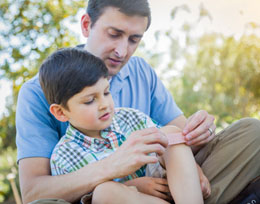Children should be taught about different first aid measures, both at home and at school. This helps emphasize the importance of child safety. This helps them overcome difficult situations like injuries, burns, and outdoor emergencies. First aid is all about using common sense in the hour of need.
Basic First Aid
Sometimes, children have to face unexpected and problematic situations like injuries, accidents, burns, heat strokes, etc. They should have some knowledge on how to deal with such situations. The following points would give us an idea thereupon.
Dangers: If a child gets injured, his peers should have the basic know-how on how to protect him, or at least minimize the danger he is facing. If a friend has met with an accident, the first thing to be done is to inform an adult about the situation, or move him to a safer place if there is no quick help available.
Splinters: Splinters are the most common cause of concern among children. They tend to roam around barefooted, which leaves them vulnerable. Before trying to remove a splinter, one should wash their hands to avoid any infection. One should proceed further, only if the splinter is small enough and can be removed easily. If it is deeply embedded, it should be removed only by a doctor. Administering a tetanus booster after the removal of a splinter is necessary.
CPR (Cardio Pulmonary Resuscitation): In order to perform CPR, prior training is necessary. It should be performed only if the affected person doesn't show any signs of life. In this process, the person who provides first-aid, has to press on the lower-half of the breastbone of the person in need. Compressions followed by 2 breaths complete the cycle. The cycle should be repeated until the affected person regains consciousness.
Burns: Burns should be treated with cool water. Treating a burn injury this way reduces the sting, and helps a quick recovery. It also minimizes the damage to the skin. A blistering burn should however, be attended to by some elder person in the house.
Cuts: These are first be cleaned with water. Children should be taught how to stop a cut from bleeding, by applying pressure.
Poison Ivy Rash: This rash develops after one comes in contact with a poison ivy plant. Usually, such cases are often seen during outdoor camps. The treatment for such a rash includes cleaning with alcohol, followed by water. While washing with water, one should avoid using soaps. After the above two steps, a warm water shower should be taken and the rash should be cleaned with soap. Finally, any belongings that might have come in contact with the plant, should be washed and cleaned with the help of water and alcohol. This needs to be done in order to prevent further infection.
Helpline Numbers
Children should be aware of helpline numbers, to access the necessary help in times of emergency. Helpline numbers prove useful in dealing with a number of problems ranging from minor injuries to serious situations. At the age of 4-5 years, a child should be aware of the process of contacting emergency help.
First Aid Courses
First aid courses are available for children, to learn how to deal with emergency situations systematically. Compact discs with complete course packages are available in the market. These courses are beneficial, because they allow children to learn at their own pace and in the comfort of their homes. Another advantage of using such CDs is that one can refresh his knowledge about the procedures of basic first aid, as per the requirements. It is also a cost-effective way of learning.
Thus, basic first aid knowledge comes in handy for kids while dealing with problematic situations like sunburns, injuries, and accidents.

No comments:
Post a Comment